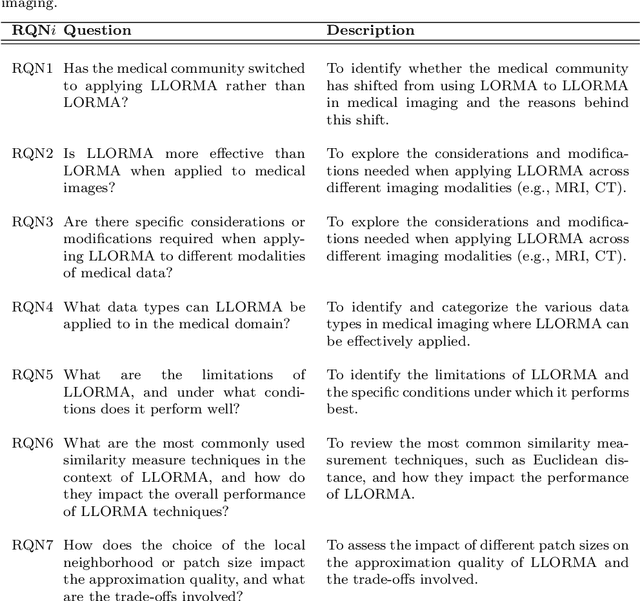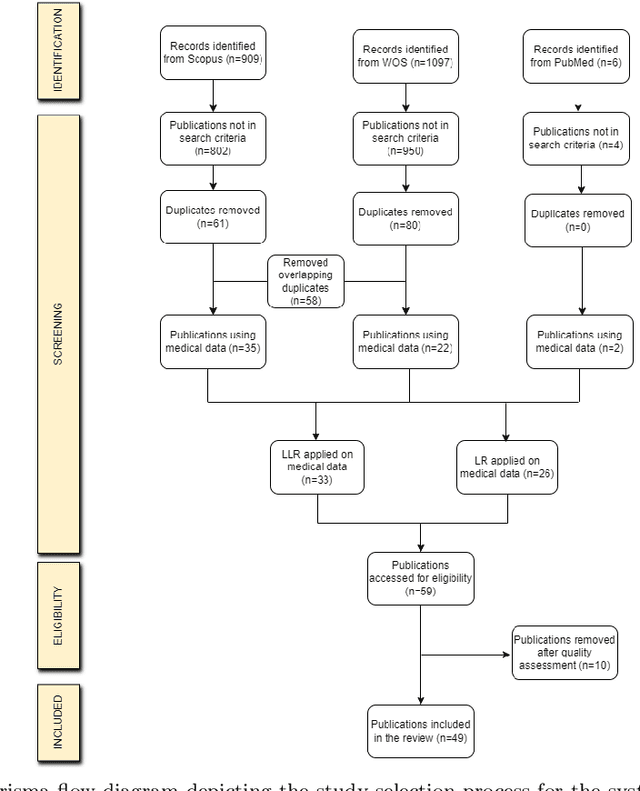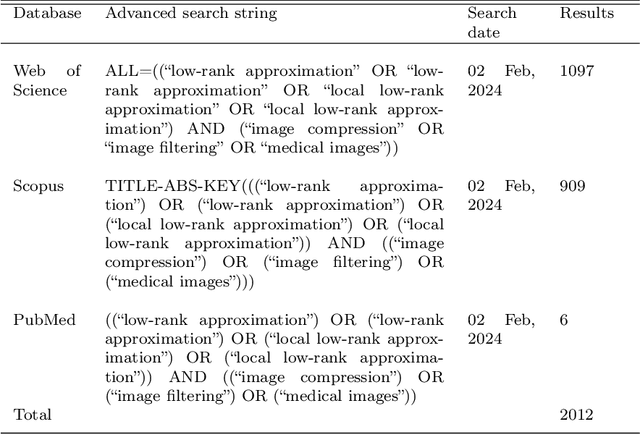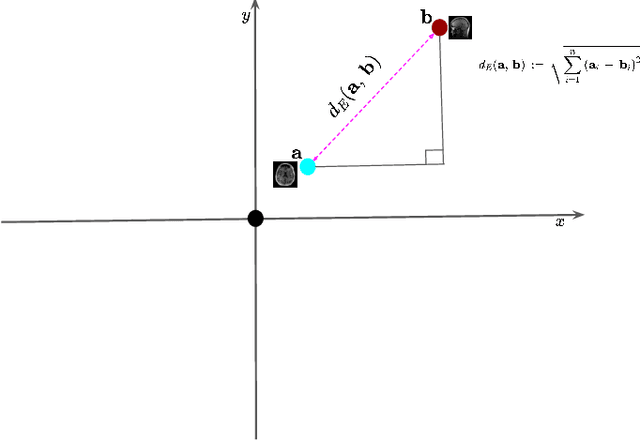Marcellin Atemkeng
Clustering-based Low-Rank Matrix Approximation: An Adaptive Theoretical Analysis with Application to Data Compression
May 13, 2025Abstract:Low-rank matrix approximation (LoRMA) is a fundamental tool for compressing high-resolution data matrices by extracting important features while suppressing redundancy. Low-rank methods, such as global singular value decomposition (SVD), apply uniform compression across the entire data matrix, often ignoring important local variations and leading to the loss of fine structural details. To address these limitations, we introduce an adaptive LoRMA, which partitions data matrix into overlapping patches, groups structurally similar patches into several clusters using k-means, and performs SVD within each cluster. We derive the overall compression factor accounting for patch overlap and analyze how patch size influences compression efficiency and computational cost. While the proposed adaptive LoRMA method is applicable to any data exhibiting high local variation, we focus on medical imaging due to its pronounced local variability. We evaluate and compare our adaptive LoRMA against global SVD across four imaging modalities: MRI, ultrasound, CT scan, and chest X-ray. Results demonstrate that adaptive LoRMA effectively preserves structural integrity, edge details, and diagnostic relevance, as measured by peak signal-to-noise ratio (PSNR), structural similarity index (SSIM), mean squared error (MSE), intersection over union (IoU), and edge preservation index (EPI). Adaptive LoRMA significantly minimizes block artifacts and residual errors, particularly in pathological regions, consistently outperforming global SVD in terms of PSNR, SSIM, IoU, EPI, and achieving lower MSE. Adaptive LoRMA prioritizes clinically salient regions while allowing aggressive compression in non-critical regions, optimizing storage efficiency. Although adaptive LoRMA requires higher processing time, its diagnostic fidelity justifies the overhead for high-compression applications.
Unsupervised anomaly detection in large-scale estuarine acoustic telemetry data
Feb 03, 2025



Abstract:Acoustic telemetry data plays a vital role in understanding the behaviour and movement of aquatic animals. However, these datasets, which often consist of millions of individual data points, frequently contain anomalous movements that pose significant challenges. Traditionally, anomalous movements are identified either manually or through basic statistical methods, approaches that are time-consuming and prone to high rates of unidentified anomalies in large datasets. This study focuses on the development of automated classifiers for a large telemetry dataset comprising detections from fifty acoustically tagged dusky kob monitored in the Breede Estuary, South Africa. Using an array of 16 acoustic receivers deployed throughout the estuary between 2016 and 2021, we collected over three million individual data points. We present detailed guidelines for data pre-processing, resampling strategies, labelling process, feature engineering, data splitting methodologies, and the selection and interpretation of machine learning and deep learning models for anomaly detection. Among the evaluated models, neural networks autoencoder (NN-AE) demonstrated superior performance, aided by our proposed threshold-finding algorithm. NN-AE achieved a high recall with no false normal (i.e., no misclassifications of anomalous movements as normal patterns), a critical factor in ensuring that no true anomalies are overlooked. In contrast, other models exhibited false normal fractions exceeding 0.9, indicating they failed to detect the majority of true anomalies; a significant limitation for telemetry studies where undetected anomalies can distort interpretations of movement patterns. While the NN-AE's performance highlights its reliability and robustness in detecting anomalies, it faced challenges in accurately learning normal movement patterns when these patterns gradually deviated from anomalous ones.
Advancing Low-Rank and Local Low-Rank Matrix Approximation in Medical Imaging: A Systematic Literature Review and Future Directions
Feb 21, 2024



Abstract:The large volume and complexity of medical imaging datasets are bottlenecks for storage, transmission, and processing. To tackle these challenges, the application of low-rank matrix approximation (LRMA) and its derivative, local LRMA (LLRMA) has demonstrated potential. This paper conducts a systematic literature review to showcase works applying LRMA and LLRMA in medical imaging. A detailed analysis of the literature identifies LRMA and LLRMA methods applied to various imaging modalities. This paper addresses the challenges and limitations associated with existing LRMA and LLRMA methods. We note a significant shift towards a preference for LLRMA in the medical imaging field since 2015, demonstrating its potential and effectiveness in capturing complex structures in medical data compared to LRMA. Acknowledging the limitations of shallow similarity methods used with LLRMA, we suggest advanced semantic image segmentation for similarity measure, explaining in detail how it can measure similar patches and their feasibility. We note that LRMA and LLRMA are mainly applied to unstructured medical data, and we propose extending their application to different medical data types, including structured and semi-structured. This paper also discusses how LRMA and LLRMA can be applied to regular data with missing entries and the impact of inaccuracies in predicting missing values and their effects. We discuss the impact of patch size and propose the use of random search (RS) to determine the optimal patch size. To enhance feasibility, a hybrid approach using Bayesian optimization and RS is proposed, which could improve the application of LRMA and LLRMA in medical imaging.
Anomaly Detection in Power Generation Plants with Generative Adversarial Networks
Sep 30, 2023



Abstract:Anomaly detection is a critical task that involves the identification of data points that deviate from a predefined pattern, useful for fraud detection and related activities. Various techniques are employed for anomaly detection, but recent research indicates that deep learning methods, with their ability to discern intricate data patterns, are well-suited for this task. This study explores the use of Generative Adversarial Networks (GANs) for anomaly detection in power generation plants. The dataset used in this investigation comprises fuel consumption records obtained from power generation plants operated by a telecommunications company. The data was initially collected in response to observed irregularities in the fuel consumption patterns of the generating sets situated at the company's base stations. The dataset was divided into anomalous and normal data points based on specific variables, with 64.88% classified as normal and 35.12% as anomalous. An analysis of feature importance, employing the random forest classifier, revealed that Running Time Per Day exhibited the highest relative importance. A GANs model was trained and fine-tuned both with and without data augmentation, with the goal of increasing the dataset size to enhance performance. The generator model consisted of five dense layers using the tanh activation function, while the discriminator comprised six dense layers, each integrated with a dropout layer to prevent overfitting. Following data augmentation, the model achieved an accuracy rate of 98.99%, compared to 66.45% before augmentation. This demonstrates that the model nearly perfectly classified data points into normal and anomalous categories, with the augmented data significantly enhancing the GANs' performance in anomaly detection. Consequently, this study recommends the use of GANs, particularly when using large datasets, for effective anomaly detection.
Label Assisted Autoencoder for Anomaly Detection in Power Generation Plants
Feb 06, 2023Abstract:One of the critical factors that drive the economic development of a country and guarantee the sustainability of its industries is the constant availability of electricity. This is usually provided by the national electric grid. However, in developing countries where companies are emerging on a constant basis including telecommunication industries, those are still experiencing a non-stable electricity supply. Therefore, they have to rely on generators to guarantee their full functionality. Those generators depend on fuel to function and the rate of consumption gets usually high, if not monitored properly. Monitoring operation is usually carried out by a (non-expert) human. In some cases, this could be a tedious process, as some companies have reported an exaggerated high consumption rate. This work proposes a label assisted autoencoder for anomaly detection in the fuel consumed by power generating plants. In addition to the autoencoder model, we added a labelling assistance module that checks if an observation is labelled, the label is used to check the veracity of the corresponding anomaly classification given a threshold. A consensus is then reached on whether training should stop or whether the threshold should be updated or the training should continue with the search for hyper-parameters. Results show that the proposed model is highly efficient for reading anomalies with a detection accuracy of $97.20\%$ which outperforms the existing model of $96.1\%$ accuracy trained on the same dataset. In addition, the proposed model is able to classify the anomalies according to their degree of severity.
What do Deep Neural Networks Learn in Medical Images?
Aug 01, 2022



Abstract:Deep learning is increasingly gaining rapid adoption in healthcare to help improve patient outcomes. This is more so in medical image analysis which requires extensive training to gain the requisite expertise to become a trusted practitioner. However, while deep learning techniques have continued to provide state-of-the-art predictive performance, one of the primary challenges that stands to hinder this progress in healthcare is the opaque nature of the inference mechanism of these models. So, attribution has a vital role in building confidence in stakeholders for the predictions made by deep learning models to inform clinical decisions. This work seeks to answer the question: what do deep neural network models learn in medical images? In that light, we present a novel attribution framework using adaptive path-based gradient integration techniques. Results show a promising direction of building trust in domain experts to improve healthcare outcomes by allowing them to understand the input-prediction correlative structures, discover new bio-markers, and reveal potential model biases.
Predicting Fuel Consumption in Power Generation Plants using Machine Learning and Neural Networks
Feb 11, 2022Abstract:The instability of power generation from national grids has led industries (e.g., telecommunication) to rely on plant generators to run their businesses. However, these secondary generators create additional challenges such as fuel leakages in and out of the system and perturbations in the fuel level gauges. Consequently, telecommunication operators have been involved in a constant need for fuel to supply diesel generators. With the increase in fuel prices due to socio-economic factors, excessive fuel consumption and fuel pilferage become a problem, and this affects the smooth run of the network companies. In this work, we compared four machine learning algorithms (i.e. Gradient Boosting, Random Forest, Neural Network, and Lasso) to predict the amount of fuel consumed by a power generation plant. After evaluating the predictive accuracy of these models, the Gradient Boosting model out-perform the other three regressor models with the highest Nash efficiency value of 99.1%.
Automatic Speech Recognition using limited vocabulary: A survey
Aug 23, 2021



Abstract:Automatic Speech Recognition (ASR) is an active field of research due to its huge number of applications and the proliferation of interfaces or computing devices that can support speech processing. But the bulk of applications is based on well-resourced languages that overshadow under-resourced ones. Yet ASR represents an undeniable mean to promote such languages, especially when design human-to-human or human-to-machine systems involving illiterate people. An approach to design an ASR system targeting under-resourced languages is to start with a limited vocabulary. ASR using a limited vocabulary is a subset of the speech recognition problem that focuses on the recognition of a small number of words or sentences. This paper aims to provide a comprehensive view of mechanisms behind ASR systems as well as techniques, tools, projects, recent contributions, and possibly future directions in ASR using a limited vocabulary. This work consequently provides a way to go when designing ASR system using limited vocabulary. Although an emphasis is put on limited vocabulary, most of the tools and techniques reported in this survey applied to ASR systems in general.
 Add to Chrome
Add to Chrome Add to Firefox
Add to Firefox Add to Edge
Add to Edge